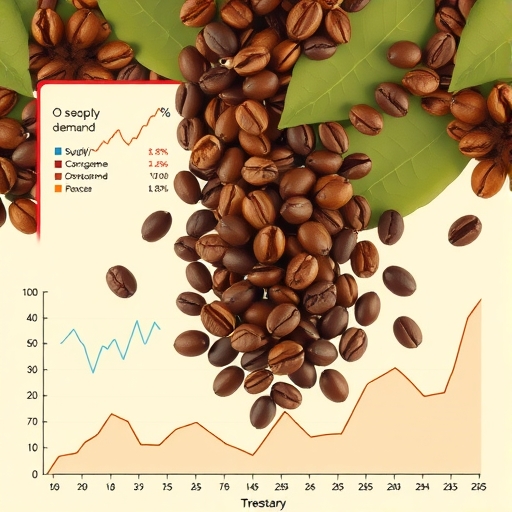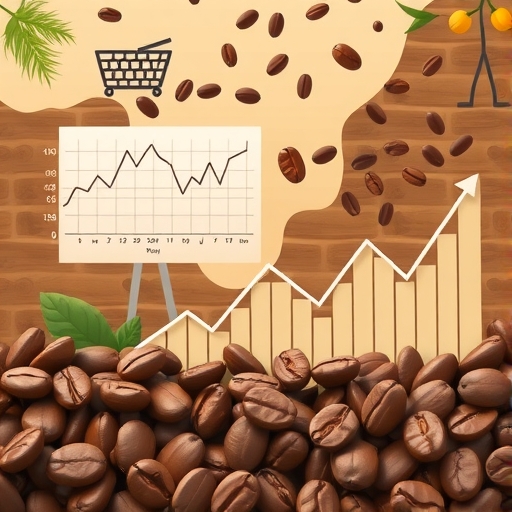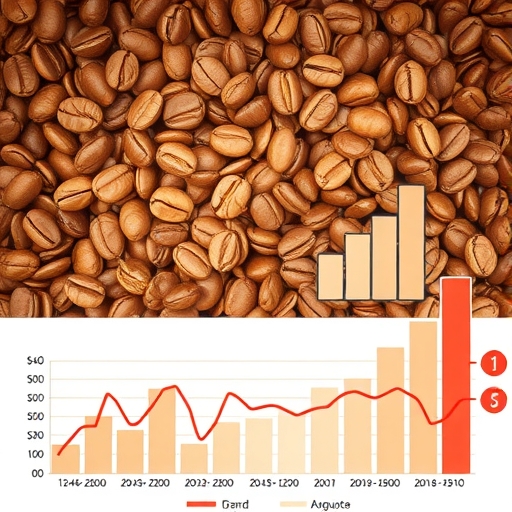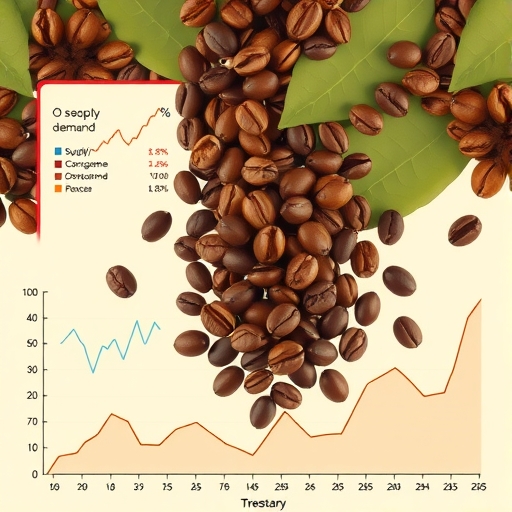The Global Coffee Market Plunge: Decoding the Dynamics of Supply, Demand, and Price
Welcome to our exploration of the fascinating, yet sometimes turbulent, world of commodity trading, specifically focusing today on the recent dramatic shifts in the global coffee market. If you’re new to investing or looking to deepen your understanding of how global factors influence market prices, coffee offers a compelling case study. We’ve seen significant price movements in recent months, and understanding the forces behind them is crucial for anyone looking to navigate commodity markets.
- Recent price volatility in the coffee market reflects broader trends and challenges.
- Supply chain disruptions and weather patterns are crucial variables influencing prices.
- The relationship between Arabica and Robusta coffee significantly affects market dynamics.
Just a few months ago, coffee prices were soaring, reaching multi-year highs and even flirting with all-time records. But more recently, we’ve witnessed a substantial correction, with futures prices for both Arabica and Robusta varieties plummeting. What caused this sudden reversal? The answer lies in the complex interplay of supply forecasts, weather patterns, harvesting progress, and the ever-present influence of market sentiment and speculative positioning. Let’s break down the key drivers behind this recent market turbulence, offering you a clearer picture of what’s happening and why it matters.

A Deep Dive into the Recent Coffee Price Collapse
Let’s start by looking at the numbers, because they tell a powerful story. Both
| Coffee Type | Price (USD per pound) | Change (%) |
|---|---|---|
| Arabica | $2.92 | -11% |
| Robusta | $3.46 | -12% |
| Highest Price (Feb 2025) | $4.40 | N/A |
If we look back further, benchmark prices (often tracked via CFDs for ease of trading) had risen to peaks around 301.48 US cents per pound by early July, a daily gain at that moment, but this figure masked a sharp recent decline. Over the past month, prices fell by more than 11%. This steep drop followed a period where prices were still dramatically higher, about 35% higher than they were a year ago. The peak of this rally saw benchmark coffee reach an all-time high around 440.85 US cents per pound in February 2025.
The decline in Arabica was particularly notable, plummeting to as low as 280 US cents per pound, hitting levels not seen since November 2024. This sharp downturn from highs exceeding 400 cents per pound (with records near 430 cents in February) naturally raised concerns and adjustments across the entire coffee supply chain, from growers to roasters to traders like you and us.
Meanwhile, Robusta coffee, primarily grown in countries like Vietnam and Indonesia and popular in Europe for espresso blends, experienced an even more dramatic descent. From highs around $5,850 per ton in February and $5,500 in April, Robusta prices fell sharply, reaching approximately $3,460 per ton by late June. This marked its lowest level in over a year, a steeper percentage drop than observed in Arabica over the same period.
What does this sharp price correction tell us immediately? It signals a significant shift in market sentiment and the underlying fundamental outlook. The primary driver cited by market analysts for this widespread decline is the anticipated increase in global coffee supply. Let’s explore that in more detail.
The Driving Force: Abundant Supply Forecasts Take Center Stage
Commodity prices, perhaps more directly than many other asset classes, are fundamentally governed by the forces of supply and demand. When market participants anticipate a significant increase in supply relative to demand, prices tend to fall. This is precisely what appears to be happening in the coffee market.
Key agricultural authorities, such as the
| Forecasting Authority | 2025/26 Coffee Harvest (Million Bags) | Change (%) |
|---|---|---|
| USDA | 65 | +0.5% |
| CONAB | 55.7 | +2.7% |
The USDA, for instance, recently projected Brazil’s 2025/26 coffee harvest to reach around 65 million 60 kg bags. This represents a slight increase (0.5%) from the previous year’s estimate and includes approximately 40.9 million bags of Arabica and 24.1 million bags of Robusta. Think of a ‘bag’ as the standard unit of measurement in the coffee trade – it’s a 60-kilogram sack of green coffee beans.
CONAB, providing Brazil-specific data, has also been reporting encouraging numbers. While their forecast for the current 2024/25 crop was revised slightly downwards in an earlier January report to 54.21 million bags, their first forecast for the 2025 crop, reported in January 2025, suggested a potential 4.40% reduction from the previous year’s *potential*, indicating variability. However, their revised *actual* crop forecast for 2024/25 saw an *increase* to 55.7 million bags (a 2.7% increase from the prior year), actually exceeding a prior record by 1%.
This CONAB increase for 2024/25 was largely attributed to a strong 28% rise specifically in the Robusta crop. This robust (pun intended!) increase in Robusta production from Brazil is a major factor in the overall improved supply outlook and helps explain the sharper decline in Robusta prices we discussed earlier. It underscores how granular reports can influence different parts of the market.

Beyond Brazil, the USDA forecasts a record global crop of 178.7 million bags. This record is anticipated to be driven by increased production not just from Brazil but also from other major players like Vietnam, Indonesia, and Ethiopia. When the collective output from the world’s largest coffee-producing nations is expected to be higher, it naturally weighs on prices.
Furthermore, harvest progress in Brazil is a closely watched indicator. Reports, such as from Cooxupe (a major Brazilian cooperative), indicating harvest is underway (though perhaps slightly behind the pace of the previous year on a specific date like June 27th, showing 31.4% completion), confirm that new supply is indeed coming to market. Amidst relatively low existing stocks, the arrival of new harvest supply directly adds to market availability and pressure on prices.
Navigating the Complexities: Underlying Uncertainties and Varietal Splits
While the overarching narrative points to increased supply, the picture isn’t entirely black and white. As experienced traders know, markets are rarely moved by a single factor. There are always nuances, uncertainties, and dynamics specific to different components of the market, in this case, the different coffee varieties.
Despite the positive overall supply forecasts, there are concerns surrounding the quality and final yield of Brazil’s Arabica crop. Reports have emerged about potential quality losses due to issues like coffee cherries detaching from trees, possibly linked to weather effects. While the overall forecast might be large, if a significant portion of the crop suffers quality degradation, the supply of high-grade Arabica could be less abundant than the headline numbers suggest. This potential uncertainty can act as a floor, preventing Arabica prices from falling too drastically.
Adding to this, while CONAB forecasts an overall increase in Brazil’s total crop (driven by Robusta), they specifically anticipate a 6.6% year-on-year decrease in Brazil’s *Arabica* crop. Similarly, the USDA forecasts a decline in Colombia’s Arabica crop this year. These forecasts, if they materialize, suggest that the Arabica market might face less overwhelming supply pressure compared to the Robusta market. This divergence in the outlook for the two varieties is crucial.
This leads us to another critical point: the relationship between Arabica and Robusta prices, specifically the
With Robusta prices falling much more steeply, Robusta has become considerably more affordable relative to Arabica. This widening price gap can influence demand, potentially encouraging roasters and consumers to substitute cheaper Robusta into blends where possible. This phenomenon has caused the Arabica over Robusta price premium to rebound sharply. After trading at a relatively narrow premium of around 20% in Autumn 2024, the premium has now rebounded to approximately 80%, a level not seen for over two years. This dramatic shift in the premium reflects the differing supply pressures and potential demand shifts between the two varieties.
Beyond production forecasts and varietal differences, market structure indicators also play a role. For example, monitoring
Another important data point comes from export figures. Brazil’s green coffee exports, for instance, showed a significant increase in the first seven months of the current coffee year (July-June), being 5.70% higher year-on-year as of the February 2025 report. Data from organizations like Cecafé (Brazil’s Coffee Exporters Association) tracks these flows, offering real-time insights into how much coffee is leaving the country. Strong export numbers reinforce the high supply narrative.
Even with these insights, markets are also influenced by the actions of large traders and speculators. The
Putting it Together: What Does This Mean for Traders?
Analyzing market reports, forecasts, and indicators like stocks and COT data is a fundamental aspect of trading commodities or any financial instrument influenced by supply and demand dynamics. For new investors or traders, understanding these forces provides a crucial context that complements technical analysis. Technical analysis helps you identify price trends and potential entry/exit points, but fundamental analysis, like reviewing these coffee market reports, helps you understand *why* those trends are occurring and what might drive future movements.
The recent coffee price plunge serves as a powerful reminder of how quickly market narratives can shift based on updated information. A few months ago, concerns about weather and potentially lower crops fueled a rally. Now, improved forecasts for a larger harvest are dominating the conversation, leading to a sharp correction.
Trading commodities like coffee (often done via futures or CFDs), or even looking at related sectors like agricultural stocks, requires diligence in staying informed. You need to keep an eye on reports from entities like the USDA and CONAB, track weather patterns in key growing regions, monitor export data, and understand the positioning of large speculators through reports like COT.

Understanding these global markets can also provide valuable insights for diversifying your trading activities. While coffee might seem distinct, the principles of supply and demand, the impact of geopolitical or environmental factors, and the role of market sentiment are applicable across various asset classes, including forex, energies, and metals.
If you’re broadening your trading horizons beyond just stocks, you might consider exploring different markets like forex or other commodity CFDs. Understanding the tools and platforms available is key to trading these diverse assets effectively.
If you’re considering starting your journey into forex trading or exploring a wider range of CFD instruments, then
Looking Ahead: The Road Ahead for Coffee Prices
So, what can we anticipate for the coffee market in the near future? While the recent price plunge has been significant, the market remains sensitive to incoming data.
- Harvest Progress: The speed and success of the harvest in Brazil and other producing nations will continue to be a major factor. Any unexpected delays or quality issues during harvest could slow the flow of new supply and provide price support.
- Weather: Weather remains a wildcard. While recent rain forecasts in Brazil helped pressure prices, future weather events – too much rain, too little rain, or unexpected cold snaps – could still impact crop estimates and introduce volatility.
- Demand: While the focus has been on supply, changes in global consumption patterns, influenced by economic conditions, could also play a role. For example, the outlook for US coffee consumption anticipates marginal growth, which is a steady, albeit not explosive, demand factor.
- Varietal Dynamics: The widening Arabica/Robusta premium is a situation to watch. If Robusta remains significantly cheaper, we might see a sustained shift in demand towards Robusta-heavy blends, potentially providing support for Robusta prices relative to Arabica, or conversely, weighing further on Arabica if substitution is easy.
- Stocks: Monitoring certified stock levels on the exchanges will be important. If stocks continue to decrease despite the new harvest, it could signal underlying physical market tightness that provides a floor for prices. Conversely, a significant build-up in stocks would add further downward pressure.
Analysts’ forecasts reflect this complexity. Some forecasts, such as those from Trading Economics, anticipated coffee prices to recover slightly towards the end of the current quarter (e.g., 325.62 USd/Lbs) and potentially move higher over 12 months (e.g., 344.98 USd/Lbs). However, these forecasts are based on assumptions about supply and demand that can change rapidly as new data emerges. The market’s volatility, demonstrated by the recent plunge from multi-year highs, underscores that price movements can be sharp and swift.
The ongoing investment in physical infrastructure, such as the opening of a new green coffee warehouse in the central US (like the one StoneX Specialty opened in Kansas City), also indicates confidence in the long-term importance of the coffee trade and the need for efficient logistics to handle supply flow.
Understanding Market Structures: Futures, CFDs, and How You Can Participate
How do individuals and institutions actually trade coffee? Large players often trade through the futures market on exchanges like ICE. Futures contracts are standardized legal agreements to buy or sell a commodity at a predetermined price at a specified time in the future. This is how producers hedge price risk and large speculators take positions based on their market outlook.
For many retail traders and investors, directly participating in the futures market might be too complex or require significant capital. This is where instruments like Contracts for Difference (CFDs) come in. A CFD is an agreement to exchange the difference in the price of an asset from the time the contract is opened until it is closed. CFDs allow you to speculate on the price movement of commodities like coffee, as well as forex pairs, indices, stocks, and other assets, without owning the underlying asset. This offers flexibility and often requires less initial capital than trading futures directly.
Trading CFDs on commodities or currency pairs requires a reliable trading platform and a broker that provides access to these markets. The choice of platform can significantly impact your trading experience, affecting factors like trade execution speed, access to charting tools, availability of research, and customer support.
When you are seeking a trading platform,
Applying EEAT Principles in Market Analysis
As we analyze markets like coffee, it’s important to rely on information that adheres to the principles of EEAT: Experience, Expertise, Authoritativeness, and Trustworthiness. This means sourcing data from reputable organizations (like USDA, CONAB, ICO), considering analysis from experienced market participants (like major banks or trading firms whose views are reported), and understanding the context and limitations of the data.
- Experience: Seasoned traders and analysts have seen market cycles before and can often interpret current events in light of historical patterns. While history doesn’t repeat exactly, experience provides valuable perspective.
- Expertise: Organizations like the USDA and CONAB have dedicated teams of agricultural economists and statisticians with deep expertise in crop forecasting and market analysis. Relying on their reports provides a foundation of expert knowledge.
- Authoritativeness: Official government reports and data from major exchanges or established trade organizations carry significant authority. They are based on extensive data collection and analysis processes.
- Trustworthiness: A trustworthy source provides transparent data, methodology where possible, and avoids making unfounded or overly speculative claims. Cross-referencing information from multiple reputable sources also builds a more trustworthy picture.
By focusing on information from sources with demonstrated EEAT, we can build a more reliable understanding of market dynamics, whether we’re analyzing coffee, oil, gold, or currency pairs.
Conclusion: A Market Defined by Shifting Fundamentals
The global coffee market is currently navigating a period of significant change, marked by a sharp price decline driven primarily by forecasts of a substantial increase in supply, particularly from Brazil and other major producing nations. The anticipated record global crop has fundamentally altered the market’s outlook from one of tightness to one of relative abundance.
However, as we’ve explored, the situation is nuanced. Uncertainties surrounding the quality of Brazil’s Arabica crop, the forecast decline in Arabica output from Brazil and Colombia, and the dwindling levels of certified stocks on the exchange suggest that the supply pressure might be more pronounced for Robusta than for Arabica. This has led to a dramatic widening of the Arabica premium, potentially influencing demand patterns going forward.
For traders, this situation highlights the importance of staying informed about fundamental market drivers, understanding the specific dynamics of different commodities and their varieties, and being prepared for rapid price adjustments as new information becomes available. Analyzing reports from authoritative sources and understanding metrics like certified stocks and COT positioning are essential steps in building a comprehensive market view.
Whether you are trading coffee CFDs or exploring opportunities in other markets like forex, having access to reliable market data and a robust trading platform is key to executing your strategy. The principles of analyzing supply and demand, understanding market reports, and managing risk are universal across different asset classes.
If you are looking for a regulated forex broker that offers global trading capabilities,
Ultimately, the coffee market serves as a powerful example of how global agricultural conditions and economic forecasts directly translate into price movements that impact everyone from farmers to consumers. By diligently studying these dynamics, we can gain valuable insights applicable to a wide range of trading and investment activities, helping us to navigate the markets with greater knowledge and confidence.
coffee tradingFAQ
Q:What are the main factors influencing coffee prices?
A:Main factors include supply forecasts, weather conditions, production yields, and market sentiment.
Q:How does the relationship between Arabica and Robusta affect trading?
A:The price premium of Arabica over Robusta fluctuates, influencing demand and market strategies.
Q:What role do organizations like USDA and CONAB play in coffee trading?
A:They provide critical forecasts and data that affect market expectations and trading decisions.

留言